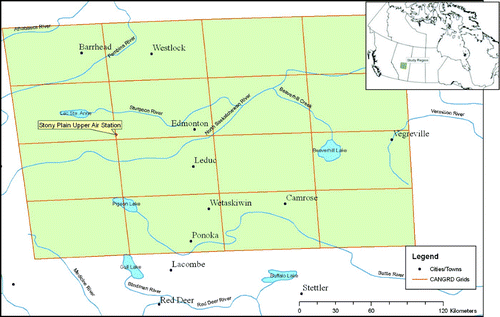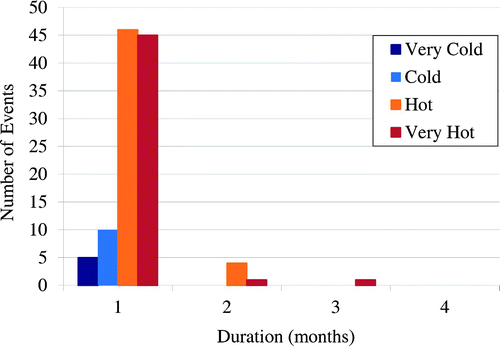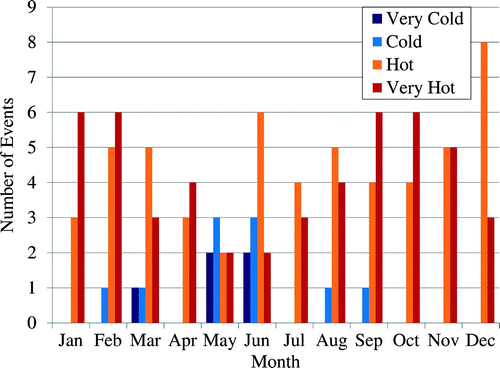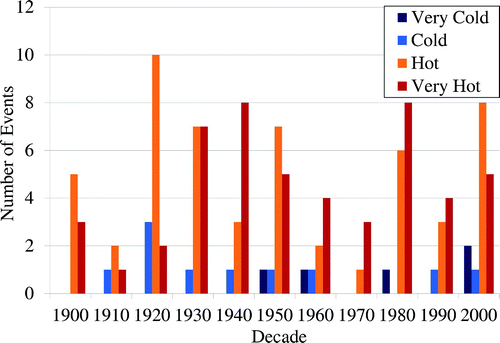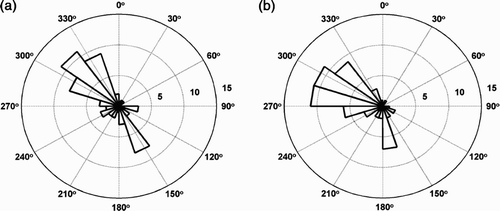Abstract
Dry conditions and droughts are a normal feature of the Canadian Prairie climate. A common perception is that these periods of below-normal precipitation are always associated with above-average temperatures. Using a core region centred near Edmonton, Alberta, this study incorporates gridded temperature and precipitation information for the period 1900–2009 to quantify how often cold, as well as hot, dry conditions occurred. Shorter-term records of atmospheric circulation, upper-air soundings and surface cloud-related variables are then used to examine some of the factors leading to these conditions. Using drought criteria based on the Standardized Precipitation Index, 15 month-long anomalously cold, dry periods were identified; this is about an order of magnitude less than the number of hot, dry periods. Cold periods generally occurred in the late spring and occurred within some of the major droughts affecting the region. The cold periods were linked with the advection of cold, dry air from the north, whereas hot periods were somewhat attributable to air descending the eastern flank of the Western Cordillera. To understand drought fully, all conditions leading to the persistent lack of precipitation need to be considered including those instances with cold temperatures.
RÉSUMÉ [Traduit par la redaction] Les conditions sèches et les sécheresses représentent un phénomène normal dans les Prairies. Il est communément admis qu'au cours de ces périodes caractérisées par des précipitations inférieures à la normale, les températures sont invariablement supérieures à la moyenne. Dans notre étude, qui porte sur une région centrale près d'Edmonton en Alberta, nous intégrons les données maillées sur les températures et les précipitations entre 1900 et 2009 afin de quantifier la fréquence à laquelle les conditions sèches par temps froid autant que par temps chaud se sont présentées. Nous nous servons ensuite des enregistrements à court terme de la circulation atmosphérique, d'observations en altitude et de variables de surface liées aux nuages afin d'examiner quelques facteurs responsables de ces conditions. Au moyen de critères de sécheresse établis en fonction de l'Indice des précipitations normales, nous avons établi qu'il y a eu 15 périodes de sécheresse de durée d'un mois par temps anormalement froid, ce qui est inférieur au nombre de périodes de sécheresse par temps chaud. Les périodes froides ont généralement eu lieu à la fin du printemps, pendant quelques-unes des grandes sécheresses qui ont frappé la région. Ces périodes étaient reliées à l'advection de l'air froid et sec provenant du nord; en revanche, les périodes chaudes étaient dans une certaine mesure attribuables à l'air descendant sur le flanc est de la Cordillère nord-américaine. Pour bien comprendre le phénomène des sécheresses, il faut tenir compte de toutes les conditions qui expliquent l'absence persistante de précipitations, y compris les occurrences avec temps froid.
1 Introduction
Drought is a major ongoing issue for Canada and, in particular, the Prairie Provinces. Whenever and wherever it occurs, major hardship ensues. Etkin et al. (Citation2004) pointed out that the most costly disasters affecting Canada were often droughts with one example being 2001–02 which led to $3.6 billion in agricultural losses alone over the Canadian Prairies (Wheaton et al., Citation2008).
The general depiction of drought is that it is characterized by hot, dry conditions during the summer period. However, anomalously cold periods have also been documented during recent severe drought events over this region. These include periods within the well-documented 1999–2005 drought (e.g., Bonsal and Wheaton, Citation2005; Hanesiak et al., Citation2011) and that of 2009 (Wittrock et al., Citation2010). In both cases, mention was only made in passing of such periods, and there was no investigation of the factors leading to them. Nonetheless, these observations illustrate that the production of precipitation can be inhibited under this temperature regime just as well as under hot conditions.
The authors are not aware of any specific study of the issue of anomalously cold periods during drought. This includes the recent review of all the research conducted on drought over Canada (Bonsal et al., Citation2011a) as well as studies of drought in other regions of the world.
As with hot, dry conditions, cold, dry periods can have serious impacts on the Canadian Prairies. For example, during spring, they can be associated with postponed seeding of agricultural crops thus delaying the maturation phase and increasing susceptibility to late growing season frosts. Furthermore, if one is to have confidence in climate change scenarios, all aspects of drought must be investigated. It is therefore important to document and understand these cold, dry occurrences.
This study's overall objective is, therefore, to document and better understand cold periods within dry conditions on the Prairies. Firstly this involves quantification of the frequency of cold dry periods during the instrumental record and then comparing it to the number of hot dry periods. Some of the atmospheric and surface-related factors associated with these temperature anomaly events are then addressed.
2 Data and methods
a Study Area
For the purposes of this analysis, a core study region within the Canadian Prairies was identified (). The particular focus was on central Alberta (centred in the Edmonton area) because this region experienced anomalously cold periods during both the most recent 1999–2005 (Bonsal and Wheaton, Citation2005) and 2009 (Wittrock et al., Citation2010) Prairie droughts. Furthermore, the only long-term radiosonde station for the agricultural region of the Prairies is located at Stony Plain (WSE, WMO ID 71119), Alberta (see ). These data (described in Section 2b) are used for atmospheric analyses of both cold and hot dry periods and are assumed to be representative of the study region.
This area is characterized by a continental climate with cold winters (average January temperature −11.5°C) and warm summers (average July temperature 16.0°C). Average annual precipitation is 459 mm; however, there is considerable interannual variability. On average, the majority (45%) of precipitation is received from June to August (all values are based on the 1971–2000 CANGRD data described in Section 2b).
b Datasets
Monthly gridded temperature and precipitation from the CANGRD dataset (Zhang et al., Citation2000) were used to identify anomalously cold dry and hot dry periods. These data originate from the 210 temperature and 489 precipitation stations in the Adjusted Historical Canadian Climate Data (AHCCD) set in which temperature homogeneity problems caused by station relocation and changes to instrumentation and observing practices have been addressed (Vincent, Citation1998; Vincent and Gullet, Citation1999). Precipitation values from the AHCCD were adjusted to account for gauge undercatch, wetting loss and trace events (Mekis and Hogg, Citation1999). The station data were gridded, with a spatial resolution of 50 km, using the Gandin optimal interpolation technique (Zhang et al., Citation2000). The dataset spans the period 1900–2009 and is produced by the Climate Research Division of Environment Canada. All temperature and precipitation gridpoint values over the study region (outlined in ) were averaged to produce monthly time series over the entire record.
This study incorporates the Standardized Precipitation Index (SPI) to identify dry periods (McKee et al., Citation1993). This index has been used extensively to characterize drought conditions and is calculated by determining observed precipitation as a standardized departure from a precipitation probability distribution function. It can be computed over any duration (e.g., 1 month, 3 months, 1 year) and is dimensionless, with negative values indicating drought of varying intensity (see Guttman, Citation1998). For example, SPI values less than or equal to −2.5 refer to exceptional drought conditions, whereas those that are less than or equal to −1 refer to moderately dry or worse drought conditions (McKee et al., Citation1993).
Several atmospheric parameters were also examined to understand the factors associated with cold dry periods better and, subsequently, to compare them to hot dry conditions. Initially, composites of geopotential heights and corresponding anomalies were generated from the National Centers for Environmental Prediction-National Center for Atmospheric Research (NCEP-NCAR) reanalysis (Kalnay et al., Citation1996) to assess the larger-scale atmospheric factors influencing these temperature and precipitation patterns. This dataset extends from 1948–2009 and anomalies were based on the 1968–1996 mean. Composites were generated from the National Oceanic and Atmospheric Admistration's (NOAA's) online plotting tool (NOAA, 2011a).
Associated atmospheric profiles were analyzed from the 43 years of sounding data (1966–2009) available from the Stony Plain upper air station (WMO ID 71119) near Edmonton (). These data include temperature, relative humidity, and wind speed and direction at all available pressure levels and were obtained from the National Climate Data and Information Archive (EC, Citation2011). Precipitable water was calculated from this sounding information. Hourly surface observations from Environment Canada for Edmonton over the period 1961–2009 were used to examine cloud-related variables including cloud fraction, cloud base height and opacity.
Collectively, the datasets described above allow for the systematic examination of conditions associated with strong temperature anomalies during identified dry periods. Because of the temporal variations in these datasets the identification of cold and hot dry periods is carried out for the period 1900–2009, the examination of larger-scale atmospheric circulation patterns for the period 1948–2009, and the site-specific upper air and surface analyses for the periods 1966–2009 and 1961–2009, respectively.
3 Cold and hot dry periods
a Criteria
The temporal scales used to identify cold and hot dry periods include 1-, 2- and 3-month timeframes. The definition of these periods also requires flexible but robust selection criteria. Consequently, dry conditions were identified as periods when the SPI was less than or equal to −1. According to McKee et al. (Citation1993), this threshold corresponds to periods that were moderately dry or worse.
Once dry periods were identified, temperature percentiles were used to differentiate between very cold dry periods (VCDP), cold dry periods (CDP), hot dry periods (HDP) and very hot dry periods (VHDP). Equation (1) shows these temperature (T) criteria where the subscript refers to the percentile. Percentiles were determined using data for the entire 1900–2009 period and are designed to account for the greater variability associated with cold season temperatures compared with those of the warm season. These percentile thresholds correspond to the approach others have taken to standardize and give context to observed environmental extremes in light of significant variability, be it temporal or spatial:
shows greater temperature variability during the cold as opposed to the warm season with the 10th and 90th percentiles as high as 6°C in January and less than 2°C in July. Note that before determining these percentiles, the temperature data were detrended using linear regression to remove the increase (2°C) in the observed mean temperature over this region during the 1900–2009 period. For comparison, the determination of cold and hot periods was also carried out with the non-detrended data; results were similar with the only difference being that dry periods were slightly more evenly distributed across the entire time series in the detrended data. Only those dry periods derived from the detrended data are shown in the following sections.
b Occurrence of Temperature Anomaly, Dry Periods
During the 1900–2009 period, only 206 of the 1320 months had an SPI less than or equal to −1 (). Of these, only 5 (2.4% of all dry months) were classified as VCDP and 10 (4.9%) as CDP. Conversely, there were many more occurrences of HDP (54) and VHDP (50). The remaining 87 dry months had temperature values near normal. Therefore, cold temperature anomalies during dry months are rare but nonetheless do occur.
also reveals that VCDPs and CDPs did not occur over periods longer than a month. In addition, there were relatively few HDPs and VHDPs over 2- and 3-month periods. As a result, the subsequent analysis focused exclusively on the 1-month dry periods.
and further illustrate the predominance of high temperature occurrences and the fact that the majority of these events occurred in the colder months (September to April). The colder temperature anomaly events on the other hand, tended to prevail during the late spring months of May and June (56% and 38%, respectively). No cold events were recorded during the October to January period.
Fig. 4 The timing of 1-month temperature anomaly dry periods over the 1900–2009 record. The horizontal axis shows the month of the year.
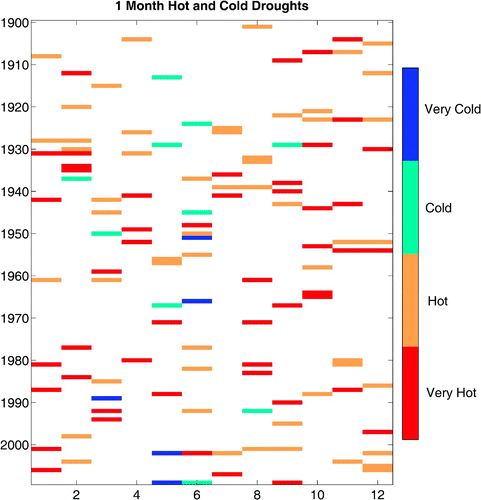
It should be noted that hot dry periods never preceded cold dry periods over the 1900–2009 record. In contrast, cold dry periods preceded hot dry periods twice (September 1929 and May 2002). However, this is such a rare event that it is probably not significant.
Decadal summaries of the 1-month temperature anomaly dry periods are shown in . There was substantial variability between decades with no discernible long-term trends. This includes minima in the 1910s and 1970s as well as peaks from the 1920s to the 1950s and in the 1980s and 2000s. Furthermore, no VCPs were observed before the 1950s. The two renowned drought decades of the 1930s and the 1980s had the same number of hot dry periods although more VHDPs occurred during the 1980s.
The occurrences of cold and hot periods during documented past major drought periods on the Prairies (as identified by Bonsal et al. (Citation2011b)) were also examined. Those that affected the study area in included August 1917 to October 1919, September 1928 to July 1930, and January 1999 to June 2005. The recently documented 2009 drought period was also severe over central Alberta (Wittrock et al., Citation2010) and is, therefore, included.
The occurrence of the CDPs and VCDPs within these major droughts varied. In one drought, 1917–1919, there were no such instances but in others, 1928–1930, 1999–2005 and 2009, there were two, one and two CDP and/or VCDPs, respectively. All of the CDPs and VCDPs occurred during the warm-season months of May to September (majority in May–June). Therefore, cold periods can occur during major drought episodes but this is not universal.
There was substantial variability with respect to HDPs and VHDPs during these identified droughts, and they tended to occur more frequently than the cold periods. For example, the longest drought period of 1999–2005 was associated with seven such periods: four during cold-season months (October to April) and three during the warm season (May to September). During other major droughts there were zero occurrences in 1917–1919, two occurrences during cold-season months in 1928–1930 and one during a warm-season month in 2009. Therefore, the timing of these HDPs and VHDPs during major droughts reveals approximately equal occurrences in both the cold and warm seasons. In summary, with the exception of the 1917–19 episode, all the major droughts affecting Alberta had both cold and hot anomalies within the same drought with the former mainly occurring during the May–June period.
4 Forcing and associated conditions
a Large-Scale Atmospheric Circulation Patterns
Large-scale atmospheric circulation patterns associated with the identified cold and hot dry periods were assessed to determine the synoptic-scale forcing factors during those events. This analysis was carried out at 850 hPa, as opposed to higher levels, to best relate circulations to surface conditions. Composite monthly 850 hPa geopotential heights and anomalies (relative to the 1968–96 period) were determined for selected periods beginning in 1948 so earlier dry periods were not included in this analysis. Composite patterns during the five VCDP months are given in a. The anomaly map shows a distinct region of strong negative anomalies centred over Hudson Bay with weaker positive anomalies over much of the United States and western Prairies. The negative anomalies are representative of a deep trough over the central continent as evident in the mean circulation. The pattern is conducive to a drier and cooler northwesterly flow over the Prairie study region and thus explains the cold temperatures during these months. Note that with the exception of June 1951, all VCDPs were associated with these strong negative height anomalies and cooler flow into the Prairies (not shown).
Fig. 7 Plots of 850 hPa geopotential height composite mean and anomalies for identified temperature anomaly dry periods occurring since 1948. (a) very cold dry conditions, (b) cold conditions, (c) hot conditions, and (d) very hot conditions. Plots were provided by NOAA (Citation2011b).
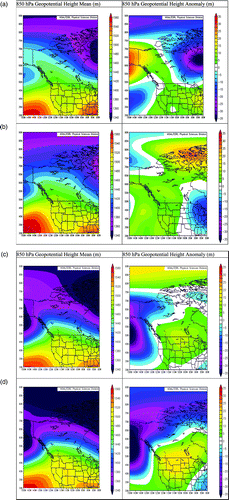
Conversely, the composite for CDP months (b) shows a somewhat different pattern when compared with VCDPs. In particular, during CDPs, the strong negative anomalies were shifted south over the eastern United States, and there were weak positive anomalies over the Prairies. However, it should be noted that examination of individual months revealed considerable variability in the patterns (not shown). March 1950 and June 2009 are similar to the composite in a in that they both have strong negative anomalies over the eastern United States but near-normal values over western Canada. This flow is conducive to colder northerly flow into the Prairie study region. May 1967 had a pattern very similar to that for VCDP in a. A much different pattern that included stronger positive height anomalies over most of North America occurred in August 1992 suggesting that other processes were involved to create the colder than normal conditions. Nonetheless, the other three months showed 850 hPa heights favourable for colder air advection into the Prairies.
For comparison, composite 850 hPa heights and anomalies associated with VHDP and HDP months were also analyzed (c and 7d). Note that these composites are based on much larger sample sizes (30 and 26, respectively) and unlike VCDP or CDPs, include cold- and warm-season months. Both the VHDP and HDP composites showed similar patterns consisting of positive height anomalies over central North America (particularly during the VHDPs) and stronger negative anomalies over the west coast and eastern Pacific Ocean. This pattern is similar to other studies which examined mid-tropospheric circulation patterns associated with dry conditions on the Prairies (e.g., Shabbar et al., Citation1997; Bonsal et al., Citation1999; Bonsal and Wheaton, Citation2005). The composite patterns are representative of meridional flow over western North America that allows warm, dry air to be advected into the Prairie study region from the west. The ridging over the Prairies also inhibits cold air advection from the north. During the cold season, the negative anomalies over the eastern Pacific are indicative of a strengthened Aleutian Low that allows milder Pacific air into the Prairie region more frequently. Examination of circulation during individual VHDP and HDP months generally revealed similar patterns to those in the composites with some variability in both the position and/or strength of the positive and negative anomalies (not shown).
In summary, although the number of VCDP and CDP months was small relative to VHDP and HDPs, a discernible difference in 850 hPa circulation patterns is evident. Specifically, the former tended to be associated with negative height anomalies or troughing to the east of the study area causing an anomalous northerly flow component into the region. Given that the source of such flow would be from cold, probably ice-covered areas including the Arctic Ocean, it would be expected that such flow would also be sub-saturated.
Conversely, the hot and warm periods had positive anomalies (i.e., ridging) over the Prairies and these are consistent with expectations from many previous studies (see Bonsal et al., Citation2011a and references therein). In this case, the flow was primarily from the Rocky Mountains implying a Chinook-type circulation where the descending air from the Rockies is hot and dry. This indicates that the hot dry periods would be driven by mainly adiabatic effects and the cold dry periods by temperature advection. Furthermore, previous studies of Prairie drought have typically deduced a high pressure ridge over western Canada. Given that, as seen here, for large-scale pressure patterns, the main criterion determining whether the period is hot or cold would therefore be the position or shape of the ridge.
b Tropospheric Winds
Given these large-scale results, it is important to assess the wind field over the Prairies during the different periods. From the Stony Plain sounding information, wind rose plots at 850 hPa were compiled for all anomalous 1966–2009 temperature periods. The majority of the dry periods, regardless of whether they were hot or cold, had predominantly northwesterly winds. This was also found when the long-term climatology was examined and is an indication of the influence of the local topography (Rocky Mountains).
Two representative examples of the typical wind directions at 850 hPa for a VCDP (March 1989) and a VHDP (January 2006) are presented in . Both plots show predominantly northwesterly wind directions, and this was consistent with the other dry periods. Although the VCDP and VHDP flows were similar, the VHDP had a slightly more westerly component. This westerly component indicates that the flow during VHDPs was downslope from the Rocky Mountains, thus, would experience adiabatic compression and be warmed accordingly, as previously inferred in Section 4a. The wind for other periods (CDPs and HDPs) showed similar directional components to those above, but there was more variability.
c Water Vapour and Surface Conditions
The lack of surface precipitation must also be linked with changes in atmospheric water content. The monthly precipitable water anomaly was plotted against the monthly temperature anomaly at 850 hPa for all temperature anomaly dry periods occurring between 1966 and 2009 (). As expected, the cold dry periods had less than normal water vapour, but in contrast the hot periods had more.
Fig. 9 Precipitable water anomaly as a function of air temperature anomaly at 850 hPa over Stony Plain for the temperature anomaly dry periods occurring during 1966 and up to 2009.
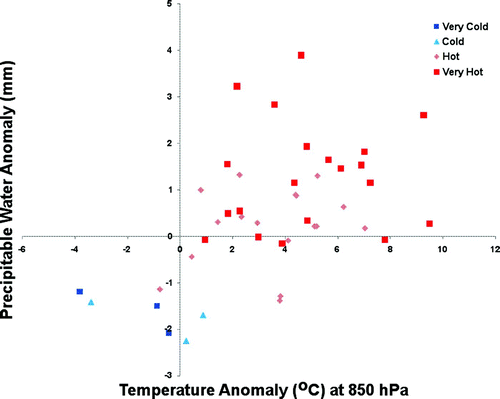
To estimate the degree to which the atmosphere as a whole was near saturation, the ratio of precipitable water relative to the maximum precipitable water the atmosphere could hold (hereafter called the “columnar relative humidity”) was computed for each temperature anomaly dry period. The climatological columnar relative humidity was 58%, whereas the average columnar relative humidity was 56% and 50% for the VCDP and VHDP, respectively. The degree of sub-saturation for the CDP and HDP was similar to that for the VCDP and VHDP, respectively, but there was more spread in the values. Therefore, both the cold and hot dry periods illustrated sub-saturated conditions. Because of the small number of occurrences of these dry periods, no statistical significance in the degree of sub-saturation could be determined between the hot and cold dry periods.
It was expected that there would be differences in the cloud-related conditions between hot and cold periods. Hourly visual sky observations reported by the station observer were used to address this issue. The lowest cloud layer amounts and opacity observations were averaged for each month to determine the cloud cover and opacity fractions. Cloud opacity characterizes the amount of cloud that is sufficiently thick to prevent viewing of the sky through it (Flysak, personal communication, 2011).
An analysis of the available information revealed no systematic differences in the cloud-related conditions between the cold and hot periods. Collectively, the monthly averages for the period were 66% cloud cover and 54% opacity, and cloud bases were at 3100 m above ground level. An analysis of the cloud types suggested that 72% of the clouds observed were convective in nature. Although both cold and hot periods showed considerable variability in these quantities, they were statistically indistinguishable. Furthermore, it was not uncommon for the cold and hot periods to have the same average characteristics as the background climatology.
5 Discussion and concluding remarks
Anomalously low precipitation periods with very cold (≤10th percentile) and cold (between the 10th and 25th percentile) temperatures have been examined over the last several decades over the Canadian Prairies in conjunction with an examination of hot (between the 75th and 90th percentile) and very hot (≥90th percentile) periods. The specific focus was the Edmonton area.
Instances of anomalously low temperature, dry conditions certainly occurred but they were rare. According to the definition used in this study, only 15 cold and very cold periods were identified over the 110-year period of record and these were all limited to a 1-month duration. Hot and very hot periods occurred an order of magnitude more often and lasted up to three months. When cold and very cold periods occurred, they tended to be in the late spring and, to a lesser extent, in the autumn. Of the four severe droughts over the last 110 years that affected the Edmonton area, the 1917–19 one did not experience a temperature anomaly; the rest experienced both cold and hot anomalies.
The large-scale atmospheric circulation patterns for all the temperature-based dry periods had distinct signatures. A key element is the occurrence of ridging across western Canada although there were important differences. The flow for the hot periods had a greater southerly component and/or tended to have a more west-northwesterly component as opposed to the cold periods which were characterized by more northwesterly components. Therefore, cold periods occurred within a large-scale pattern drawing cold, sub-saturated air from the north. In contrast, hot periods were often associated with temperatures enhanced through downslope flow and consequent adiabatic warming and drying. At the surface and apart from the actual temperature differences, there was considerable similarity during all periods in terms of cloud-related variables, but there was a great deal of variability.
Insight from this study can be applied to related issues. For example, the differences in the atmospheric circulation patterns between these relatively short-duration cold and hot dry periods raises questions regarding their association with large-scale, long-duration atmosphere-ocean patterns such as the Pacific Decadal Oscillation (PDO) and the El Niño-Southern Oscillation (ENSO) that need to be examined. It is also tempting to suggest that cold, dry periods should become less common in a future warmer climate, but this assertion needs to be confirmed. As well, there is no reason why cold dry periods should only occur over the Canadian Prairies; studies should be carried out elsewhere to examine this issue.
In summary, persistent lack of precipitation can, on occasion, be linked with below-normal temperatures as well as with above-normal ones.
Acknowledgements
The authors would like to thank the Canadian Foundation for Climate and Atmospheric Sciences whose support of the Drought Research Initiative led to this study. The authors would also like to thank Éva Mekis and Larry Flysak who provided precipitation and upper air information, respectively. Comments by anonymous reviewers led to substantial improvements in the article.
References
- Bonsal , B. , Zhang , X. and Hogg , W. D. 1999 . Canadian Prairie growing season precipitation variability and associated atmospheric circulation . Clim. Res. , 11 : 191 – 208 .
- Bonsal , B. and Wheaton , E. 2005 . Atmospheric circulation comparisons between the 2001 and 2002 and the 1961 and 1988 Canadian Prairie droughts . Atmosphere-Ocean , 43 : 163 – 172 .
- Bonsal , B. , Wheaton , E. , Chipanski , A. , Lin , C. , Sauchyn , D. and Wen , L. 2011a . Drought research in Canada: A review . Atmosphere-Ocean , 49 : 303 – 319 .
- Bonsal , B. , Wheaton , E. , Meinert , A. and Siemens , E. 2011b . Characterizing the surface features of the 1999–2005 Canadian Prairie drought in relation to previous severe twentieth century events . Atmosphere-Ocean , 49 : 320 – 338 .
- ec (Environment Canada). 2011. National Climate Data and Information Archive [Data]. Retrieved from www.climate.weatheroffice.gc.ca
- Etkin, D., E. Haque, L. Bellisario and I. Burton. 2004. An assessment of natural hazards and disasters in Canada: A report for decision-makers and practitioners. The Canadian Natural Hazards Assessment Project.
- Guttman , N. B. 1998 . Comparing the Palmer Drought Index and the Standardized Precipitation Index . J. Am. Water Res. Assoc. , 34 : 113 – 121 .
- Hanesiak , J. , Stewart , R. E. , Bonsal , B. R. , Harder , P. , Lawford , R. , Aider , R. , Amiro , B. D. , Atallah , E. , Barr , A. G. , Black , T. A. , Bullock , P. , Brimelow , J. C. , Brown , R. , Carmichael , H. , Derksen , C. , Flanagan , L. B. , Gachon , P. , Greene , H. , Gyakum , J. , Henson , W. , Hogg , E. H. , Kochtubajda , B. , Leighton , H. , Lin , C. , Luo , Y. , McCaughey , J. H. , Meinert , A. , Shabbar , A. , Snelgrove , K. , Szeto , K. , Trishchenko , A. , van der Kamp , G. , Wang , S. , Wen , L. , Wheaton , E. , Wielki , C. , Yang , Y. , Yirdaw , S. and Zha , T. 2011 . Characterization and summary of the 1999–2005 Canadian Prairie drought . Atmosphere-Ocean , 49 : 421 – 452 .
- Kalnay , E. , Kanamitsu , M. , Kistler , R. , Collins , W. , Deaven , D. , Gandin , L. , Iredell , M. , Saha , S. , White , G. , Woollen , J. , Zhu , Y. , Leetmaa , A. , Reynolds , R. , Chelliah , M. , Ebisuzaki , W. , Higgins , W. , Janowiak , J. , Mo , K. C. , Ropelewski , C. , Wang , J. , Jenne , R. and Joseph , D. 1996 . The NCEP/NCAR 40-year reanalysis project . Bull. Am. Meteorol. Soc. , 77 : 437 – 471 .
- McKee, T.B.; N.J. Doeskin and J. Kleist. 1993. The relationship of drought frequency and duration to time scales. Proc. 8th Conf. Applied Climatol, 17–22 January 1993, Am. Meteorol. Soc., Boston, Massachusetts, pp. 179–184.
- Mekis , É. and Hogg , W. D. 1999 . Rehabilitation and analysis of Canadian daily precipitation time series . Atmosphere-Ocean , 39 : 53 – 85 .
- NOAA (National Oceanic and Atmospheric Administration). 2011a. Monthly/Seasonal Climate Composites [Data]. Retrieved from the website of the Physical Sciences Division (PSD): http://www.esrl.noaa.gov/psd/cgi-bin/data/composites/printpage.pl
- NOAA . (National Oceanic and Atmospheric Administration). 2011b Daily Mean Composites [Data]. Retrieved from the website of the Physical Sciences Division (PSD): http://www.esrl.noaa.gov/psd/data/composites/day/
- Shabbar , A. , Bonsal , B. and Khandekar , M. 1997 . Canadian precipitation patterns associated with the Southern Oscillation . J. Clim. , 10 : 3016 – 3027 .
- Vincent , L. A. 1998 . A technique for the identification of inhomogeneities in Canadian temperature series . J. Clim. , 11 : 1094 – 1104 .
- Vincent , L. A. and Gullet , D. W. 1999 . Canadian historical and homogeneous temperature datasets for climate change analyses . Int. J. Climatol. , 19 : 1375 – 1388 .
- Wheaton , E. , Kulshreshtha , S. , Wittrock , V. and Koshida , G. 2008 . Dry times: Lessons from the Canadian drought of 2001 and 2002 . Can. Geogr. , 52 : 241 – 262 .
- Wittrock, V.; E. Wheaton and E. Siemens. 2010. More than a close call: A preliminary assessment of the characteristics, impacts of and adaptations to the drought of 2008–2010 in the Canadian Prairies. Saskatchewan Research Council Publication No. 12803-1E10.
- Zhang , X. , Vincent , L. A. , Hogg , W. D. and Niitsoo , A. 2000 . Temperature and precipitation trends in Canada during the 20th century . Atmosphere-Ocean , 38 : 395 – 429 .
